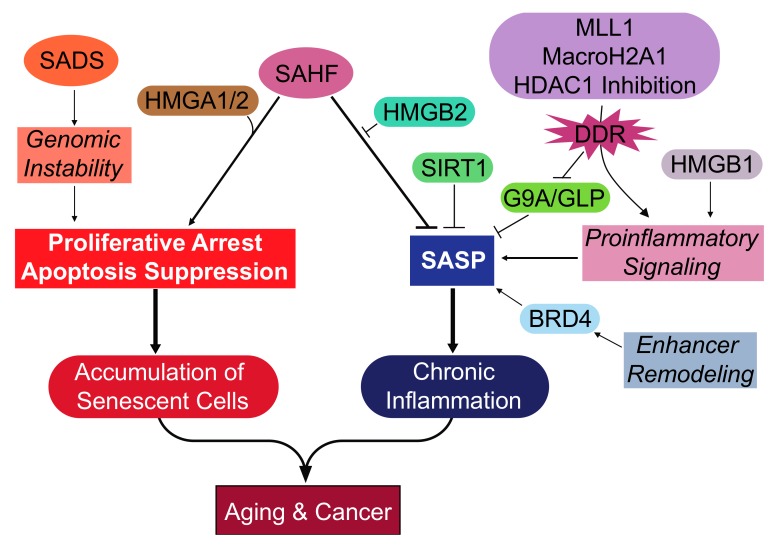Cellular senescence is a complex phenomenon characterized by irreversible cell cycle arrest and the acquisition of a senescence-associated secretory phenotype (SASP). Epigenetic modifications play a crucial role in regulating cellular senescence, making them an attractive target for research and therapeutic interventions. Epigenetically induced senescence models serve as valuable tools for basic research into the molecular underpinnings of aging and have translational implications for developing interventions to enhance healthy aging and mitigate age-related diseases.
 Fig. 1 Overview of the epigenetic events and effectors during cellular senescence. (Nacarelli T, et al., 2017)
Fig. 1 Overview of the epigenetic events and effectors during cellular senescence. (Nacarelli T, et al., 2017)
CD BioSciences, a leading biotechnology company, offers a series of services for customizing epigenetically induced senescence cellular models.
Our Approaches to Customizing Epigenetically Induced Senescence Models
Heterochromatin modification
Heterochromatin refers to the condensed and transcriptionally silent regions of the genome. CD BioSciences employs various techniques to modulate heterochromatin to induce senescence in target cells. We utilize advanced technologies to selectively alter DNA methylation patterns in specific genomic regions associated with senescence-related genes. Our customization services enable clients to study the effects of targeted gene silencing on cellular senescence.
Histone modification
Post-translational modifications of histones, such as methylation, acetylation, and phosphorylation, can influence gene expression by altering chromatin structure. We leverage various techniques to manipulate histone modifications in a precise and controlled manner, thereby inducing senescence in target cells.
Chromatin remodeling
Chromatin remodeling refers to the dynamic alteration of chromatin structure to regulate gene expression. CD BioSciences employs various methods, including the use of ATP-dependent chromatin remodelers and histone chaperones, to remodel chromatin and induce senescence in target cells. Our approach offers a powerful tool for investigating the epigenetic mechanisms underlying cellular senescence.
Workflow of Customizing Epigenetically Induced Senescence Models
Customizing epigenetically induced senescence models involves a systematic workflow that CD BioSciences follows to ensure reliable and reproducible results. The workflow typically includes the following steps:
- Cell line selection. Selecting the right cell line is crucial for the successful construction of epigenetically induced senescence models. We assist clients in selecting appropriate cell lines based on their specific research needs.
- Experimental design. We collaborate closely with researchers to design experiments tailored to their scientific objectives, including determining the appropriate control groups, and time points.
- Senescence induction. We apply customized approaches to induce senescence in the selected cell lines. Our services involve targeted manipulation of DNA methylation, histone modifications, chromatin remodeling, or epigenetic editing, depending on the specific requirements of the study.
- Senescence phenotypic characterization. Once senescence is induced, we perform a comprehensive phenotypic characterization of the senescent cells, such as assessment of cell cycle arrest, senescent-associated gene expression patterns, senescence-associated secretory phenotype (SASP) markers, and other relevant senescence-related features.
- Data analysis and interpretation. Our experts assist clients in identifying significant changes in gene expression, epigenetic modifications, and other relevant parameters. Our clear and concise data interpretation helps clients draw meaningful conclusions from experiments.
CD BioSciences offers abundant services for customizing epigenetically induced senescence cellular models. Leveraging our expertise, researchers can advance their understanding of senescence and contribute to the development of novel therapeutic strategies targeting aging-related diseases. If you are interested in our services, please feel free to contact us or make an online inquiry.
Reference
- Nacarelli T, et al. Epigenetic Basis of Cellular Senescence and Its Implications in Aging. Genes (Basel), 2017, 8 (12): 343.
All of our services and products are intended for preclinical research use only and cannot be used to diagnose, treat or manage patients.



 Fig. 1 Overview of the epigenetic events and effectors during cellular senescence. (Nacarelli T, et al., 2017)
Fig. 1 Overview of the epigenetic events and effectors during cellular senescence. (Nacarelli T, et al., 2017)